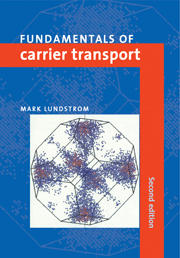Book contents
- Frontmatter
- Contents
- Preface to the second edition
- Preface to the first edition
- An overview
- 1 The quantum foundation
- 2 Carrier scattering
- 3 The Boltzmann transport equation
- 4 Low-field transport
- 5 Balance equations
- 6 Monte Carlo simulation
- 7 High-field transport in bulk semiconductors
- 8 Carrier transport in devices
- 9 Transport in mesoscopic structures
- Appendix 1 Summary of indicial notation and tensors
- Appendix 2 Some useful integrals
- Index
Preface to the first edition
Published online by Cambridge University Press: 30 March 2010
- Frontmatter
- Contents
- Preface to the second edition
- Preface to the first edition
- An overview
- 1 The quantum foundation
- 2 Carrier scattering
- 3 The Boltzmann transport equation
- 4 Low-field transport
- 5 Balance equations
- 6 Monte Carlo simulation
- 7 High-field transport in bulk semiconductors
- 8 Carrier transport in devices
- 9 Transport in mesoscopic structures
- Appendix 1 Summary of indicial notation and tensors
- Appendix 2 Some useful integrals
- Index
Summary
The operation of semiconductor devices is controlled by how electrons and holes respond to applied, built-in, and scattering potentials. Electrical engineers are used to treating transport phenomenologically – carriers drift in electric fields and diffuse in concentration gradients. For much of the past 40 years during which semiconductor technology advanced from point-contact transistors to megabit memories, drift–diffusion equations have served as the backbone of device analysis. As devices continue to decrease in size and increase in sophistication, however, this simple picture of carrier transport is beginning to lose validity. Device engineers now need a clear understanding of the physics of carrier transport in a variety of semiconductors as well as an understanding of the nature of transport in modern, small devices. The focus of this book is on carrier transport fundamentals beginning at the microscopic level and progressing to the macroscopic effects relevant to devices. The reader should acquire an understanding of the general features of low- and high-field transport in common semiconductors as well as of the characteristics of transport in small devices. He or she should learn how to evaluate scattering rates and mobilities from the semiconductor's material properties and should understand the various approaches commonly used to analyze and simulate devices.
The book is directed at electrical engineering graduate students or practicing device engineers who typically possess a mature understanding of semiconductor fundamentals and devices but only an acquaintance with the basics of quantum mechanics and solid-state physics.
- Type
- Chapter
- Information
- Fundamentals of Carrier Transport , pp. xiv - xviPublisher: Cambridge University PressPrint publication year: 2000

